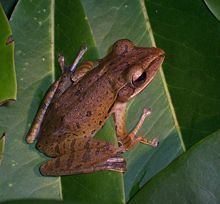Order Anura Genus Polypedates Higher classification Polypedates | Phylum Chordata Scientific name Polypedates leucomystax Rank Species | |
 | ||
Similar Frog, Polypedates, Amphibians, Rhacophorus, Rhacophoridae | ||
Common tree frog polypedates leucomystax in singapore
Polypedates leucomystax is a species in the shrub frog family Rhacophoridae. It is known under numerous common names, including common tree frog, four-lined tree frog, golden tree frog or striped tree frog. Many past authors have united it with the common Indian tree frog in P. maculatus (or Rhacophorus maculatus, as was common in older times), but today they are generally considered distinct species. In its native range, it is also called "white-lipped tree frog", but this name is otherwise applied to a species of true tree frogs (family Hylidae).
Contents
- Common tree frog polypedates leucomystax in singapore
- Common tree frog quack side view
- Range
- Habitat
- In captivity
- References
Polypedates leucomystax is not considered a threatened species by the IUCN. It is in fact a species complex containing various cryptic species within it.
Common tree frog quack side view
Range
It is found in Bangladesh, Brunei, Cambodia, China, India, Indonesia, Laos, Malaysia, Myanmar, Nepal, the Philippines, Singapore, Thailand, Vietnam, and possibly Bhutan. It has been introduced to Japan.
The range of P. leucomystax has recently expanded in the Philippines and Indonesia due to the widespread conversion of forests into agricultural-use land. It is also frequently found in trans-island agricultural shipments. Lineages on the Indochina mainland are more diverse.
In Indonesia, it has been found throughout the archipelago in Borneo, Mentawai, Sumatra, Java, Sulawesi, Bali, Lombok, Natuna Islands, Anambas Islands, Sumbawa, Sumba, Flores, and Timor, and has also been introduced to Papua. In Japan, where it has been introduced, it is found on the islands of Okinawa, Tonaki, Kurima, Miyako, Ie, Iheya, Izena, Sesoko, and Yabuchi.
4 major haplotype clades of P. leucomystax have been recognized by Brown, et. al (2010), with the clades other than the southern Sunda region clade likely to be cryptic species.
Divergent varieties that are either P. cf. leucomystax or P. cf. megacephalus have been found in southern China (including Hainan) and Vietnam.
Habitat
Its natural habitats are subtropical or tropical dry forests, subtropical or tropical moist lowland forests, subtropical or tropical moist montane forests, subtropical or tropical moist shrubland, subtropical or tropical seasonally wet or flooded lowland grassland, rivers, intermittent rivers, freshwater lakes, intermittent freshwater lakes, freshwater marshes, intermittent freshwater marshes, freshwater springs, rocky shores, coastal freshwater lagoons, arable land, pastureland, plantations, rural gardens, urban areas, water storage areas, ponds, aquaculture ponds, irrigated land, seasonally flooded agricultural land, and introduced vegetation.
In captivity
This species of tree frog is commonly kept in captivity in vivariums and terrariums by both hobbyists and professional.
